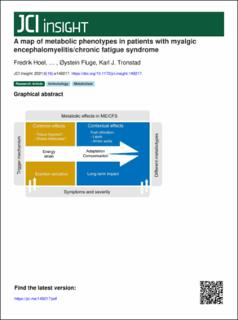| dc.contributor.author | Hoel, Fredrik | |
| dc.contributor.author | Hoel, August | |
| dc.contributor.author | Pettersen, Ina Katrine Nitschke | |
| dc.contributor.author | Rekeland, Ingrid Gurvin | |
| dc.contributor.author | Risa, Kristin | |
| dc.contributor.author | Alme, Kine | |
| dc.contributor.author | Sørland, Kari | |
| dc.contributor.author | Fosså, Alexander | |
| dc.contributor.author | Lien, Katarina | |
| dc.contributor.author | Herder, Ingrid | |
| dc.contributor.author | Thurmer, Hanne | |
| dc.contributor.author | Gotaas, Merethe Otelie Eide | |
| dc.contributor.author | Schäfer, Christoph | |
| dc.contributor.author | Berge, Rolf K. | |
| dc.contributor.author | Sommerfelt, Kristian | |
| dc.contributor.author | Marti, Hans Peter | |
| dc.contributor.author | Dahl, Olav | |
| dc.contributor.author | Mella, Olav | |
| dc.contributor.author | Fluge, Øystein | |
| dc.contributor.author | Tronstad, Karl Johan | |
| dc.date.accessioned | 2021-09-29T11:43:48Z | |
| dc.date.available | 2021-09-29T11:43:48Z | |
| dc.date.created | 2021-08-30T09:47:08Z | |
| dc.date.issued | 2021 | |
| dc.identifier.issn | 2379-3708 | |
| dc.identifier.uri | https://hdl.handle.net/11250/2786016 | |
| dc.description.abstract | Myalgic encephalomyelitis/chronic fatigue syndrome (ME/CFS) is a debilitating disease usually presenting after infection. Emerging evidence supports that energy metabolism is affected in ME/CFS, but a unifying metabolic phenotype has not been firmly established. We performed global metabolomics, lipidomics, and hormone measurements, and we used exploratory data analyses to compare serum from 83 patients with ME/CFS and 35 healthy controls. Some changes were common in the patient group, and these were compatible with effects of elevated energy strain and altered utilization of fatty acids and amino acids as catabolic fuels. In addition, a set of heterogeneous effects reflected specific changes in 3 subsets of patients, and 2 of these expressed characteristic contexts of deregulated energy metabolism. The biological relevance of these metabolic phenotypes (metabotypes) was supported by clinical data and independent blood analyses. In summary, we report a map of common and context-dependent metabolic changes in ME/CFS, and some of them presented possible associations with clinical patient profiles. We suggest that elevated energy strain may result from exertion-triggered tissue hypoxia and lead to systemic metabolic adaptation and compensation. Through various mechanisms, such metabolic dysfunction represents a likely mediator of key symptoms in ME/CFS and possibly a target for supportive intervention. | en_US |
| dc.language.iso | eng | en_US |
| dc.publisher | American Society for Clinical Investigation | en_US |
| dc.rights | Navngivelse 4.0 Internasjonal | * |
| dc.rights.uri | http://creativecommons.org/licenses/by/4.0/deed.no | * |
| dc.title | A map of metabolic phenotypes in patients with myalgic encephalomyelitis/chronic fatigue syndrome | en_US |
| dc.type | Journal article | en_US |
| dc.type | Peer reviewed | en_US |
| dc.description.version | publishedVersion | en_US |
| dc.rights.holder | Copyright 2021 the authors | en_US |
| dc.source.articlenumber | e149217 | en_US |
| cristin.ispublished | true | |
| cristin.fulltext | original | |
| cristin.qualitycode | 1 | |
| dc.identifier.doi | 10.1172/jci.insight.149217 | |
| dc.identifier.cristin | 1929629 | |
| dc.source.journal | JCI Insight | en_US |
| dc.identifier.citation | JCI Insight. 2021, 6 (16), e149217. | en_US |
| dc.source.volume | 6 | en_US |
| dc.source.issue | 16 | en_US |

